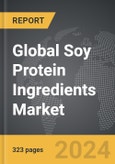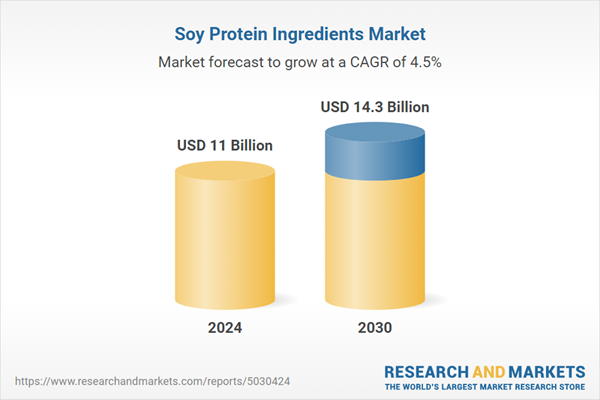The global market for Soy Protein Ingredients was valued at US$11.0 Billion in 2024 and is projected to reach US$14.3 Billion by 2030, growing at a CAGR of 4.5% from 2024 to 2030. This comprehensive report provides an in-depth analysis of market trends, drivers, and forecasts, helping you make informed business decisions. The report includes the most recent global tariff developments and how they impact the Soy Protein Ingredients market.
Segments: Type (Soy Protein Isolates, Soy Protein Concentrates, Soy Flours, Other Types); Application (Food & Beverage, Feed).
Geographic Regions/Countries: World; United States; Canada; Japan; China; Europe (France; Germany; Italy; United Kingdom; Spain; Russia; and Rest of Europe); Asia-Pacific (Australia; India; South Korea; and Rest of Asia-Pacific); Latin America (Argentina; Brazil; Mexico; and Rest of Latin America); Middle East (Iran; Israel; Saudi Arabia; United Arab Emirates; and Rest of Middle East); and Africa.
The analysts continuously track trade developments worldwide, drawing insights from leading global economists and over 200 industry and policy institutions, including think tanks, trade organizations, and national economic advisory bodies. This intelligence is integrated into forecasting models to provide timely, data-driven analysis of emerging risks and opportunities.
Global Soy Protein Ingredients Market - Key Trends and Drivers Summarized
Why Are Soy Protein Ingredients Gaining Prominence in the Food and Beverage Industry?
Soy protein ingredients are gaining significant prominence in the food and beverage industry as the demand for plant-based protein solutions continues to rise. Soy proteins, derived from whole soybeans, are valued for their high protein content, essential amino acid profile, and functional properties, making them ideal ingredients for a wide range of applications, including meat alternatives, dairy substitutes, sports nutrition, and functional foods. As consumers become more health-conscious and seek sustainable, plant-based alternatives to animal-derived proteins, the demand for soy protein ingredients, such as isolates, concentrates, and textured soy proteins, has surged. Moreover, the increasing popularity of vegan, vegetarian, and flexitarian diets is driving the adoption of soy protein ingredients in various food formulations, supporting their growth in the market.How Are Technological Advancements Influencing the Soy Protein Ingredients Market?
Technological advancements in soy protein extraction, processing, and formulation are driving innovation in the market, leading to the development of high-quality, functional, and non-GMO soy protein ingredients. The use of advanced extraction methods, such as water-based and enzymatic processes, is enhancing the purity, solubility, and digestibility of soy proteins, making them suitable for a wide range of food, beverage, and nutritional applications. The emergence of organic, clean-label, and allergen-free soy protein solutions is also gaining traction, catering to the growing demand for transparent, sustainable, and health-focused products. Additionally, advancements in texturization and extrusion technologies are enabling the creation of meat-like textures and flavors, expanding the application scope of textured soy proteins in meat alternatives, ready-to-eat meals, and snack products.Which Market Segments Are Leading the Growth of the Soy Protein Ingredients Industry?
Types of soy protein ingredients include soy protein isolates, soy protein concentrates, and textured soy proteins, with soy protein isolates holding the largest market share due to their high protein content, versatility, and use in a variety of food applications. Applications of soy protein ingredients span food and beverages, animal feed, dietary supplements, and personal care, with food and beverages being the dominant segment due to the high demand for plant-based and protein-enriched products. End-use sectors comprise meat alternatives, dairy substitutes, bakery and confectionery, sports nutrition, and beverages, with meat alternatives leading the market due to the growing popularity of plant-based diets and meat-free lifestyles. Geographically, North America and Europe are the largest markets for soy protein ingredients, driven by high consumer awareness and a strong presence of plant-based food manufacturers, while Asia-Pacific is expected to witness rapid growth due to rising health consciousness and expanding food processing industries.What Are the Key Drivers of Growth in the Soy Protein Ingredients Market?
The growth in the soy protein ingredients market is driven by several factors, including the rising demand for plant-based protein solutions, technological advancements in soy protein extraction and processing, and the increasing focus on health, wellness, and sustainable nutrition. The need to provide high-quality, functional, and versatile protein ingredients for various food and beverage applications is driving the demand for soy protein ingredients. Technological innovations in non-GMO, organic, and allergen-free soy protein solutions, coupled with advancements in texturization, flavor enhancement, and extrusion technologies, are enhancing the appeal and marketability of soy protein ingredients, supporting market growth. The expansion of soy protein applications in meat alternatives, dairy substitutes, sports nutrition, and functional foods, along with the growing emphasis on clean label, sustainable sourcing, and personalized nutrition, is creating new opportunities for market players. Additionally, the focus on developing high-protein, nutrient-dense, and environmentally friendly soy protein ingredients for diverse dietary needs is further propelling the growth of the soy protein ingredients market.Report Scope
The report analyzes the Soy Protein Ingredients market, presented in terms of units. The analysis covers the key segments and geographic regions outlined below.Segments: Type (Soy Protein Isolates, Soy Protein Concentrates, Soy Flours, Other Types); Application (Food & Beverage, Feed).
Geographic Regions/Countries: World; United States; Canada; Japan; China; Europe (France; Germany; Italy; United Kingdom; Spain; Russia; and Rest of Europe); Asia-Pacific (Australia; India; South Korea; and Rest of Asia-Pacific); Latin America (Argentina; Brazil; Mexico; and Rest of Latin America); Middle East (Iran; Israel; Saudi Arabia; United Arab Emirates; and Rest of Middle East); and Africa.
Key Insights:
- Market Growth: Understand the significant growth trajectory of the Soy Protein Isolates segment, which is expected to reach US$5.3 Billion by 2030 with a CAGR of a 5.2%. The Soy Protein Concentrates segment is also set to grow at 4.2% CAGR over the analysis period.
- Regional Analysis: Gain insights into the U.S. market, valued at $2.9 Billion in 2024, and China, forecasted to grow at an impressive 7.3% CAGR to reach $3.1 Billion by 2030. Discover growth trends in other key regions, including Japan, Canada, Germany, and the Asia-Pacific.
Why You Should Buy This Report:
- Detailed Market Analysis: Access a thorough analysis of the Global Soy Protein Ingredients Market, covering all major geographic regions and market segments.
- Competitive Insights: Get an overview of the competitive landscape, including the market presence of major players across different geographies.
- Future Trends and Drivers: Understand the key trends and drivers shaping the future of the Global Soy Protein Ingredients Market.
- Actionable Insights: Benefit from actionable insights that can help you identify new revenue opportunities and make strategic business decisions.
Key Questions Answered:
- How is the Global Soy Protein Ingredients Market expected to evolve by 2030?
- What are the main drivers and restraints affecting the market?
- Which market segments will grow the most over the forecast period?
- How will market shares for different regions and segments change by 2030?
- Who are the leading players in the market, and what are their prospects?
Report Features:
- Comprehensive Market Data: Independent analysis of annual sales and market forecasts in US$ Million from 2024 to 2030.
- In-Depth Regional Analysis: Detailed insights into key markets, including the U.S., China, Japan, Canada, Europe, Asia-Pacific, Latin America, Middle East, and Africa.
- Company Profiles: Coverage of players such as AG Processing Inc., Archer Daniels Midland Company, Biopress S.A.S., Cargill, Inc., Chs Inc. and more.
- Complimentary Updates: Receive free report updates for one year to keep you informed of the latest market developments.
Some of the 41 companies featured in this Soy Protein Ingredients market report include:
- AG Processing Inc.
- Archer Daniels Midland Company
- Biopress S.A.S.
- Cargill, Inc.
- Chs Inc.
- Devansoy, Inc.
- Dow, Inc.
- DuPont de Nemours, Inc.
- Kerry Group PLC
- Nisshin Oillio Group Ltd.
- Ruchi Soya Industries Ltd.
- The Scoular Company
- Wilmar International Ltd.
Tariff Impact Analysis: Key Insights for 2025
Global tariff negotiations across 180+ countries are reshaping supply chains, costs, and competitiveness. This report reflects the latest developments as of April 2025 and incorporates forward-looking insights into the market outlook.The analysts continuously track trade developments worldwide, drawing insights from leading global economists and over 200 industry and policy institutions, including think tanks, trade organizations, and national economic advisory bodies. This intelligence is integrated into forecasting models to provide timely, data-driven analysis of emerging risks and opportunities.
What’s Included in This Edition:
- Tariff-adjusted market forecasts by region and segment
- Analysis of cost and supply chain implications by sourcing and trade exposure
- Strategic insights into geographic shifts
Buyers receive a free July 2025 update with:
- Finalized tariff impacts and new trade agreement effects
- Updated projections reflecting global sourcing and cost shifts
- Expanded country-specific coverage across the industry
Table of Contents
I. METHODOLOGYII. EXECUTIVE SUMMARY2. FOCUS ON SELECT PLAYERSIII. MARKET ANALYSISSOUTH KOREAREST OF ASIA-PACIFICARGENTINABRAZILMEXICOREST OF LATIN AMERICAIRANISRAELSAUDI ARABIAUNITED ARAB EMIRATESREST OF MIDDLE EASTIV. COMPETITION
1. MARKET OVERVIEW
3. MARKET TRENDS & DRIVERS
4. GLOBAL MARKET PERSPECTIVE
UNITED STATES
CANADA
JAPAN
CHINA
EUROPE
FRANCE
GERMANY
ITALY
UNITED KINGDOM
SPAIN
RUSSIA
REST OF EUROPE
ASIA-PACIFIC
AUSTRALIA
INDIA
LATIN AMERICA
MIDDLE EAST
AFRICA
Companies Mentioned (Partial List)
A selection of companies mentioned in this report includes, but is not limited to:
- AG Processing Inc.
- Archer Daniels Midland Company
- Biopress S.A.S.
- Cargill, Inc.
- Chs Inc.
- Devansoy, Inc.
- Dow, Inc.
- DuPont de Nemours, Inc.
- Kerry Group PLC
- Nisshin Oillio Group Ltd.
- Ruchi Soya Industries Ltd.
- The Scoular Company
- Wilmar International Ltd.
Table Information
| Report Attribute | Details |
|---|---|
| No. of Pages | 323 |
| Published | April 2025 |
| Forecast Period | 2024 - 2030 |
| Estimated Market Value ( USD | $ 11 Billion |
| Forecasted Market Value ( USD | $ 14.3 Billion |
| Compound Annual Growth Rate | 4.5% |
| Regions Covered | Global |









